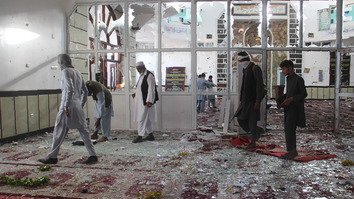KABUL -- Newly published photos suggest Tehran is trying to fuel the concept of religious war -- a cover the regime uses to portray its foreign interventions -- by allegedly deploying clerics to fight among the ranks of the Fatemiyoun Division.
Iran's Islamic Revolutionary Guard Corps (IRGC) fills the Fatemiyoun Division's ranks with Shia Afghan refugees and migrants living in Iran. The division has sent thousands of members over the years to to fight in Syria for President Bashar al-Assad's regime.
The Fatemiyoun Division published photographs on Telegram on September 23 showing religious clerics receiving military training at an undisclosed location. The clerics are being posted to the front, the group said without providing more details.
Iran is using these clerics, religious symbols and slogans, and the grinding poverty of young Afghan refugees as weapons to achieve its strategic goals in the region, Afghan analysts say.
![A cleric fires an AK-47 at an undisclosed location before joining Fatemiyoun Division front-line fighters. [Fatemiyoun Division/Telegram]](/cnmi_st/images/2019/10/25/20534-photo_2019-09-22_02-09-55-585_329.jpg)
A cleric fires an AK-47 at an undisclosed location before joining Fatemiyoun Division front-line fighters. [Fatemiyoun Division/Telegram]
![Clerics receive military training from Iranian forces in an undisclosed location before they join the Fatemiyoun Division's front-line fighters. [Fatemiyoun Division/Telegram]](/cnmi_st/images/2019/10/25/20537-photo_2019-09-22_02-10-01-585_329.jpg)
Clerics receive military training from Iranian forces in an undisclosed location before they join the Fatemiyoun Division's front-line fighters. [Fatemiyoun Division/Telegram]
Manufacturing 'religious war'
"Sending clerics and preachers of the Fatemiyoun Division to the front lines of the war in Syria is Iran's latest plan to brand the war as religious," said Muhammad Jan Rasool Yar, a political affairs analyst in Kabul and former deputy governor of Helmand Province.
"Iran doesn't want peace and stability in the region. That's why it's launched a religious war in Syria, Yemen, Bahrain, Iraq and most of the Middle Eastern countries, and why it's spread the war in the Islamic world by investing in numerous militant groups like the Fatemiyoun Division and the Zainabiyoun Brigade," he said.
The Zainabiyoun Brigade is comprised of Pakistani Shia.
The Iranian regime "duped and recruited Afghan refugees ... and unfortunately it has been recruiting desperate Afghan refugees to the Fatemiyoun Division ... for the past few years," said Mohammad Salem Hasani, a religious scholar and university lecturer in Kabul.
"Iran's efforts are centred on misusing religious and ideological symbols and slogans to achieve its national, political and military goals in the region," he said.
"Iran is giving military training to religious clerics and sending them to the front lines of the war to show that the war in Syria is religious and that defending Syria means defending the Shia faith," he said.
"Clerics sent to the front lines of the war alongside other Fatemiyoun fighters have received religious training in Iran's religious schools," he added.
Investing in militancy
"Iran's IRGC has invested in numerous militant groups in the region, especially in the Fatemiyoun Division ... and the Zainabiyoun Brigade," said Siddiq Mansoor Ansari, chairman of the Federation of Afghanistan's Civil Societies.
"Most of the Fatemiyoun Division fighters were recruited from Ghor, Badghis, Maidan Wardak, Bamiyan, Daikundi and other parts of Afghanistan," he said. "Other Fatemiyoun fighters are Afghan refugees and Afghans who went to Iran to study in religious schools."
"Shia scholars at the level of ayatollah and hujjat-ul-Islam run recruitment drives for the Fatemiyoun Division, and they recruit and deploy young Afghan refugees in exchange for $400 (31,320 AFN) per month or more," Ansari said.
"Iran wants to achieve a number of goals by sending clerics to the front lines of war," he said. "It wants to fuel a religious war, uplift the morale of Fatemiyoun fighters on the battlefields and encourage Shia youths to join the Fatemiyoun Division to defend Shia holy sites in Syria."
"Iran is trying to expand its territory and influence in the region, and it misuses the desperation and religious emotions of young refugees to achieve this goal," said Nabi Mesdaq, a Kabul-based political analyst and writer.
"Thousands of ... young refugees, who have fought Iran's proxy war in the region for years, are fed up with war," he said. "But this time Iran wants to strengthen the morale and fighting capability of these young people who are tired of war by sending clerics and preachers to the front."
The excuse that the Fatemiyoun Division and Zainabiyoun Brigade are defending Shia holy sites is a "cover-up", said Shafiqullah Noori, an international law graduate student at a private university in Kabul.
The reality is that Iran is using these fighters "as a weapon against its regional enemies and rivals and to wage its proxy wars", he said.
"The IRGC and its Quds Force exploit young Afghan refugees in violation of Islamic principles and international and humanitarian laws," he said.
"They actually don't deploy them as the defenders of [the Sayidda Zainab Mosque] but send them to the front lines of the war," Noori said. "Most of them unfortunately lose their lives because of their unfamiliarity with the Syrian terrain and because of the inadequate military training they received."

![This photo released by the Fatemiyoun Division Telegram channel in September shows a number of clerics receiving military instructions from Iranian forces at an undisclosed location before they join front-line fighters. [Fatemiyoun Division/Telegram]](/cnmi_st/images/2019/10/25/20536-photo_2019-09-22-585_329.jpg)






